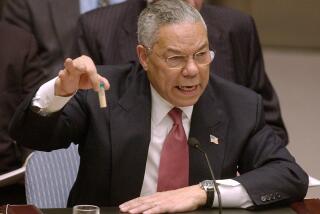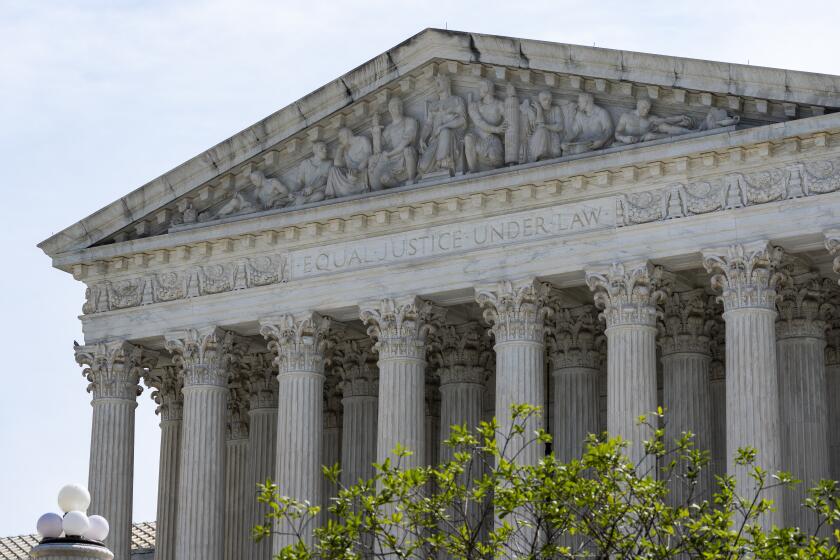The Sky Is Always Falling
- Share via
It should come as no surprise that the Pentagon may have exaggerated the Iraqi threat. Threat inflation has a long history at U.S. intelligence agencies, and it is a bipartisan pastime in Washington.
During the Cold War, the CIA, the Defense Intelligence Agency and the White House all too frequently exaggerated Soviet military capabilities.
The so-called “bomber gap” of the mid-1950s was based on an overestimation of the Soviets’ ability to produce long-range nuclear bombers. The claim was that they would produce 700 to 800 bombers by 1961. But the Soviets never built more than 150 or so. The U.S. pushed up its production of B-52 bombers and had about 750 in the early 1960s.
During the 1960 presidential campaign, John F. Kennedy hammered Richard Nixon on the Republicans’ defense policy, implying they were responsible for the “missile gap.” The missile gap was false -- and Kennedy had gotten briefings to that effect -- but the U.S. nevertheless proceeded with the production of thousands of its own ICBMs.
Similarly, the “window of vulnerability,” which survived several Democratic and Republican administrations during the ‘70s and ‘80s, was the claim that U.S. silo-based missiles were vulnerable to a surprise Soviet attack. The “window” prompted deployment of the controversial MX missile and partly fueled an escalation of Cold War tensions.
During the Reagan administration, the Pentagon produced booklets titled “Soviet Military Power” that portrayed a devastatingly powerful Warsaw Pact and Soviet military by exaggerating the numbers and technical capacities of Soviet weapons.
Why does threat inflation occur? And is the record of this administration any worse than the others?
Threats may be exaggerated for several reasons. First, analysts could simply be mistaken. For instance, the fear of a bomber gap was initially prompted by a miscounting of Soviet Bear and Bison bombers circling in air parades.
Second, there is a bias toward “worst-case” scenarios. Who wants to be the analyst that misses or underestimates a major threat?
A worst-case bias is more likely if what is to be estimated is not what another side has but what they might get or want. There is a tendency to assume that if the other side might have the capacity to do something we don’t like, they will develop their potential to the fullest.
Third, a pervasive atmosphere of fear may cause intelligence officials to see only the worst possible behavior by potential adversaries, and fear was omnipresent during the Cold War. Each scare only heightened the fear on each side and made escalation more likely.
Finally, threats may also be deliberately exaggerated for political and bureaucratic purpose -- to win elections, push a favored policy or get new weapons. This is what Kennedy did to Nixon in 1960. He knew there was no missile gap, but he repeated the charge to boost his credentials as a hawk. Similarly, the spending gap was calculated to get Ronald Reagan elected, and the window of vulnerability was to be “solved” by the MX, which the Pentagon wanted more because of its accuracy than because it was “invulnerable.”
The first three reasons for threat inflation -- an honest mistake, a conscious worse-case bias and the unconscious bias induced by fear -- are understandable and often correctable. But the political manipulation of “threats” is more difficult to correct without external oversight.
In the case of Iraq, mistake, worst-case bias and fear may have been at play. But the administration also may have ignored information that didn’t fit its preconceived notions and exaggerated the intelligence it liked.
Deliberate threat inflation is a breach of trust between the government and its people. It can have dangerous international consequences by potentially damaging U.S. credibility or causing the U.S. to take actions that are unnecessarily provocative or reckless. And it potentially creates more fear and hostility at home and abroad, fueling a cycle of arms racing and war mongering.
Congress should be applauded for initiating an investigation of the administration’s production of Iraq intelligence. But it also must further insulate intelligence analysts from political pressure.
I am not saying that we can never trust the intelligence agencies and analysts. Threats are not always exaggerated. But threat inflation, whether inadvertent or deliberate, is probably as dangerous as missing or underestimating threats.
More to Read
Sign up for Essential California
The most important California stories and recommendations in your inbox every morning.
You may occasionally receive promotional content from the Los Angeles Times.













